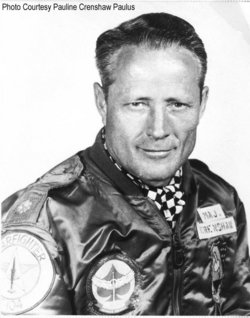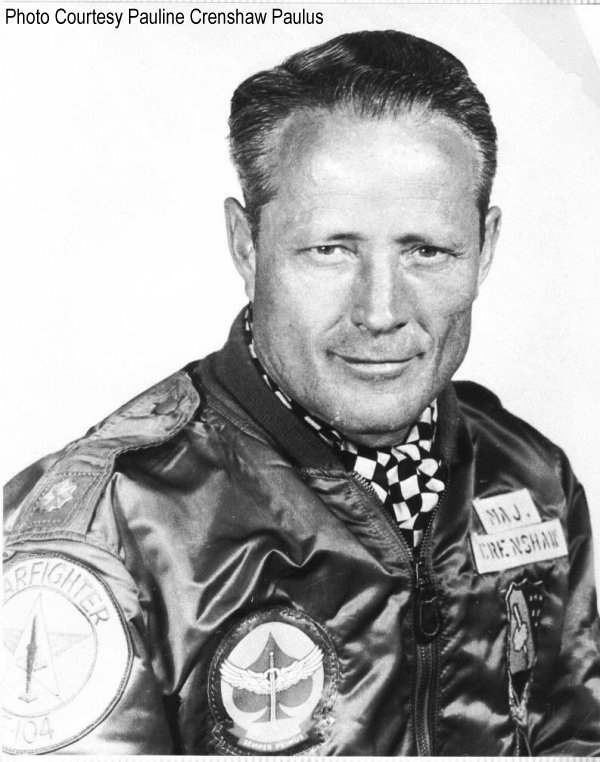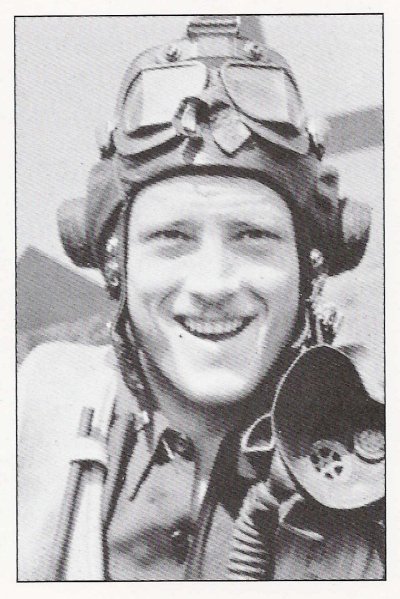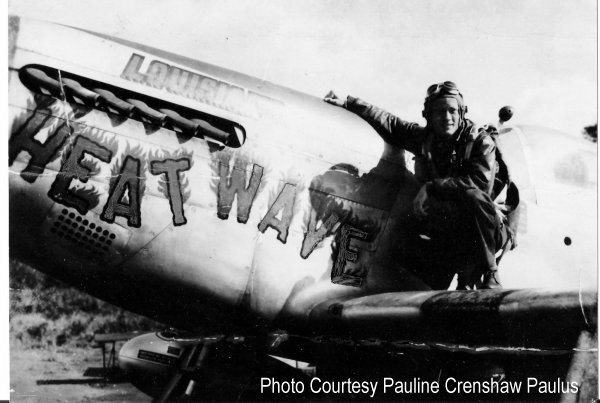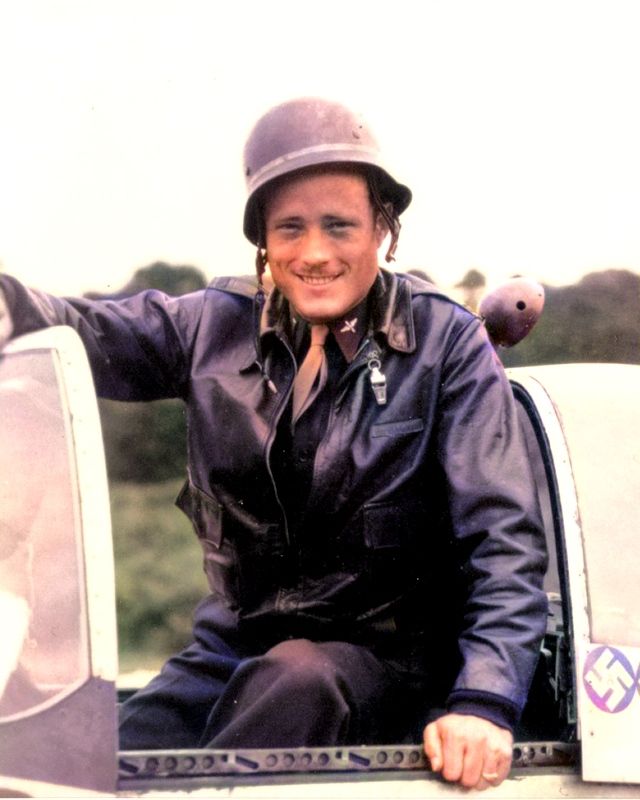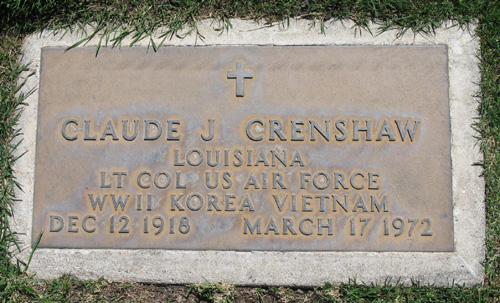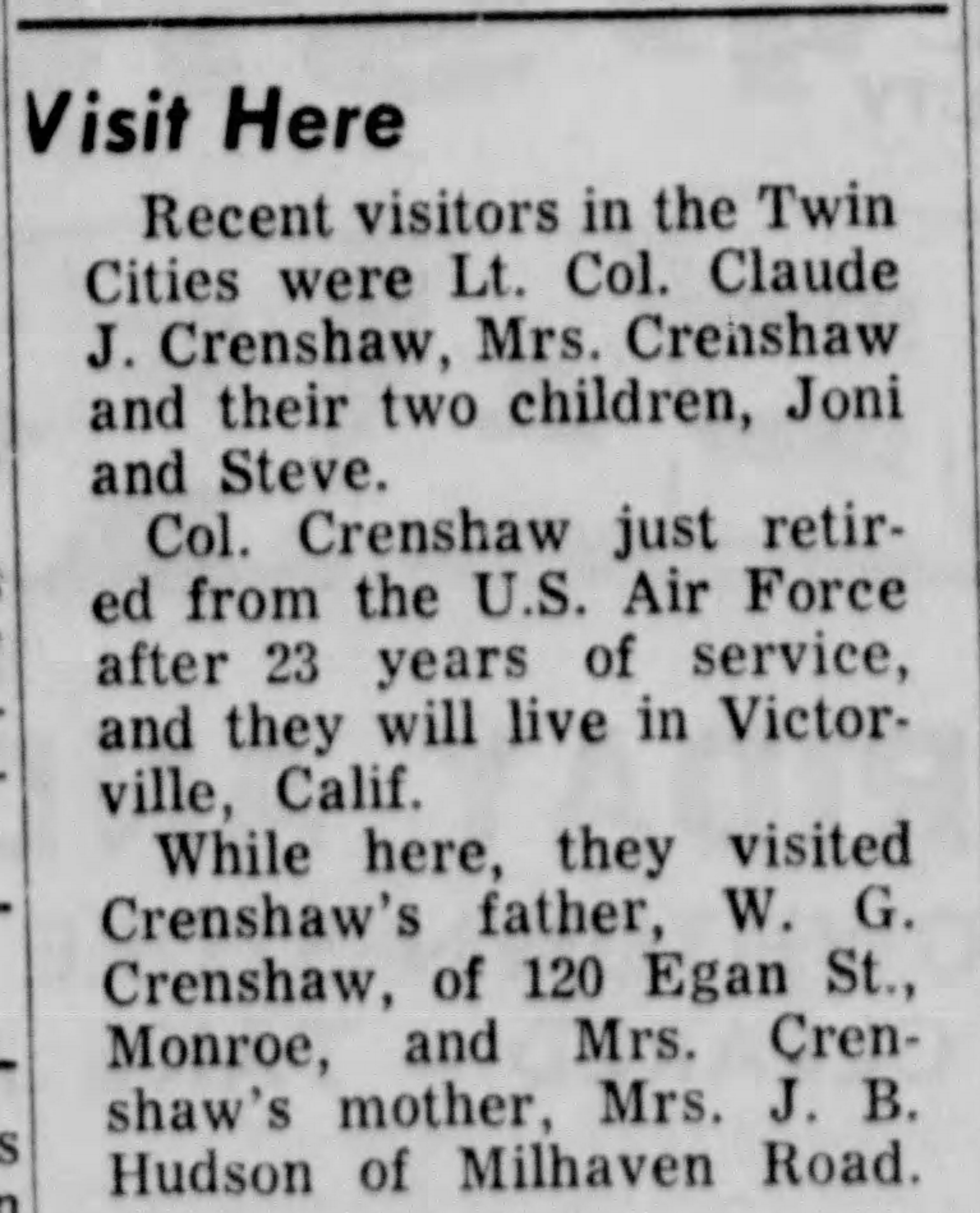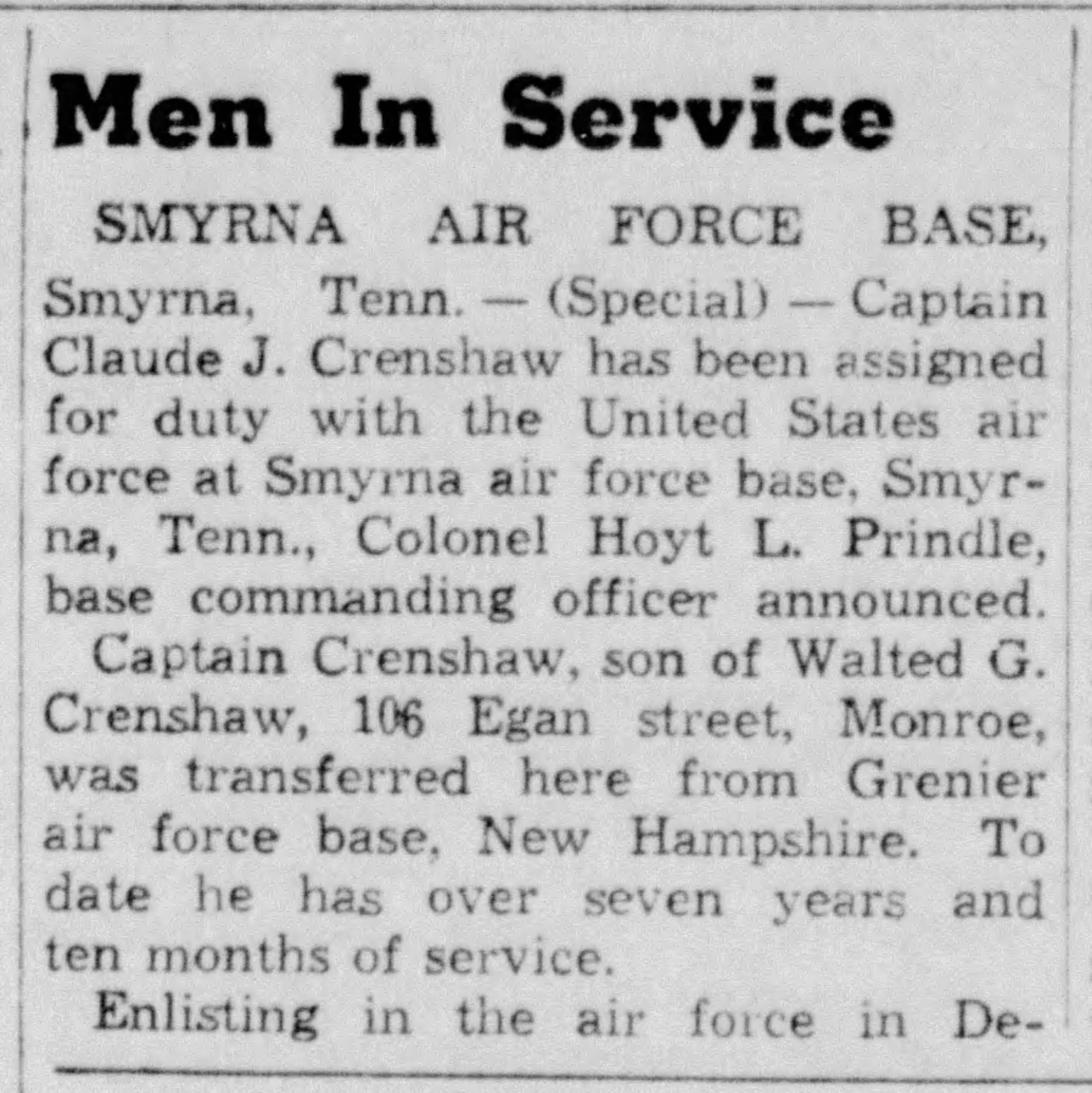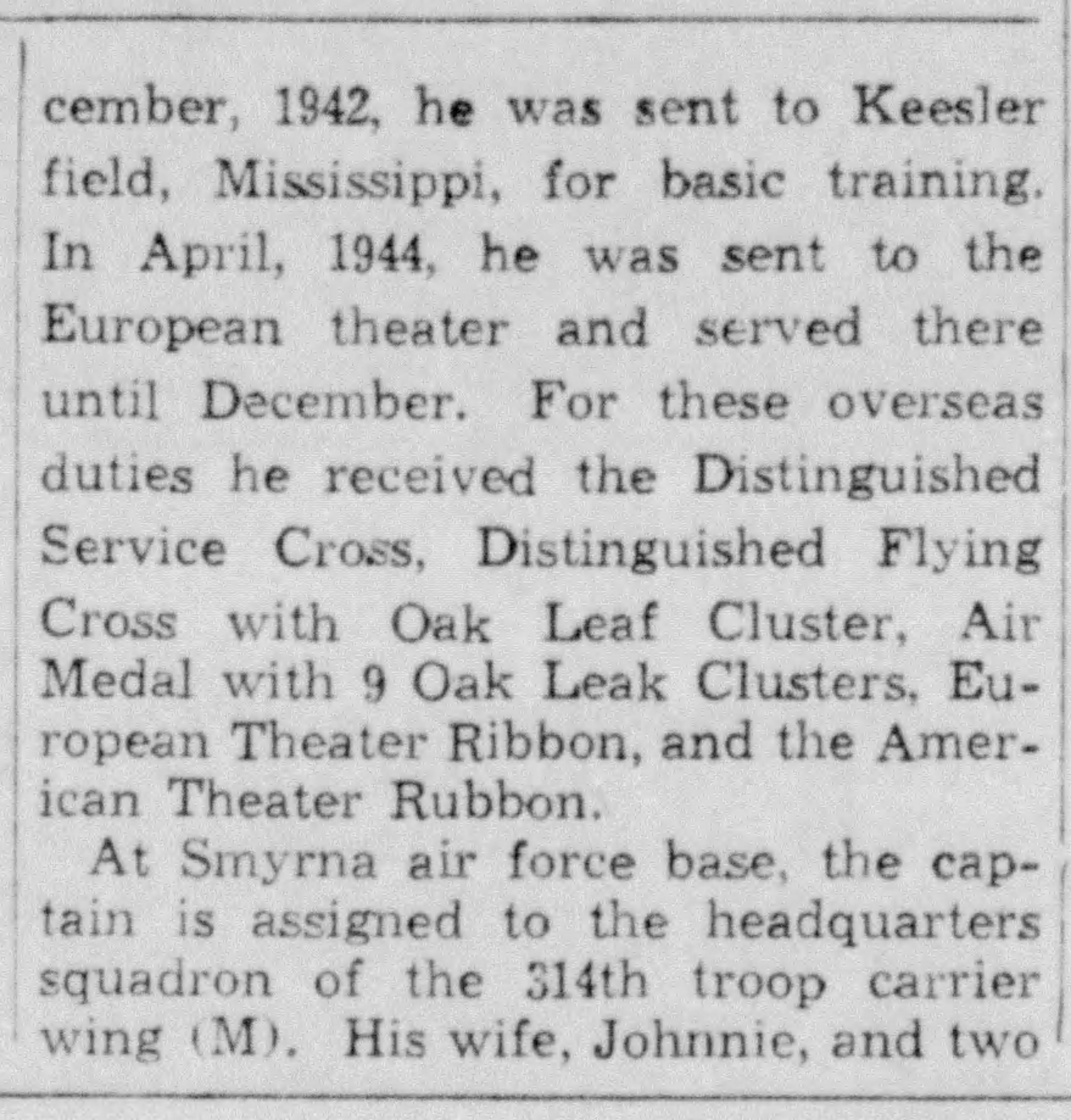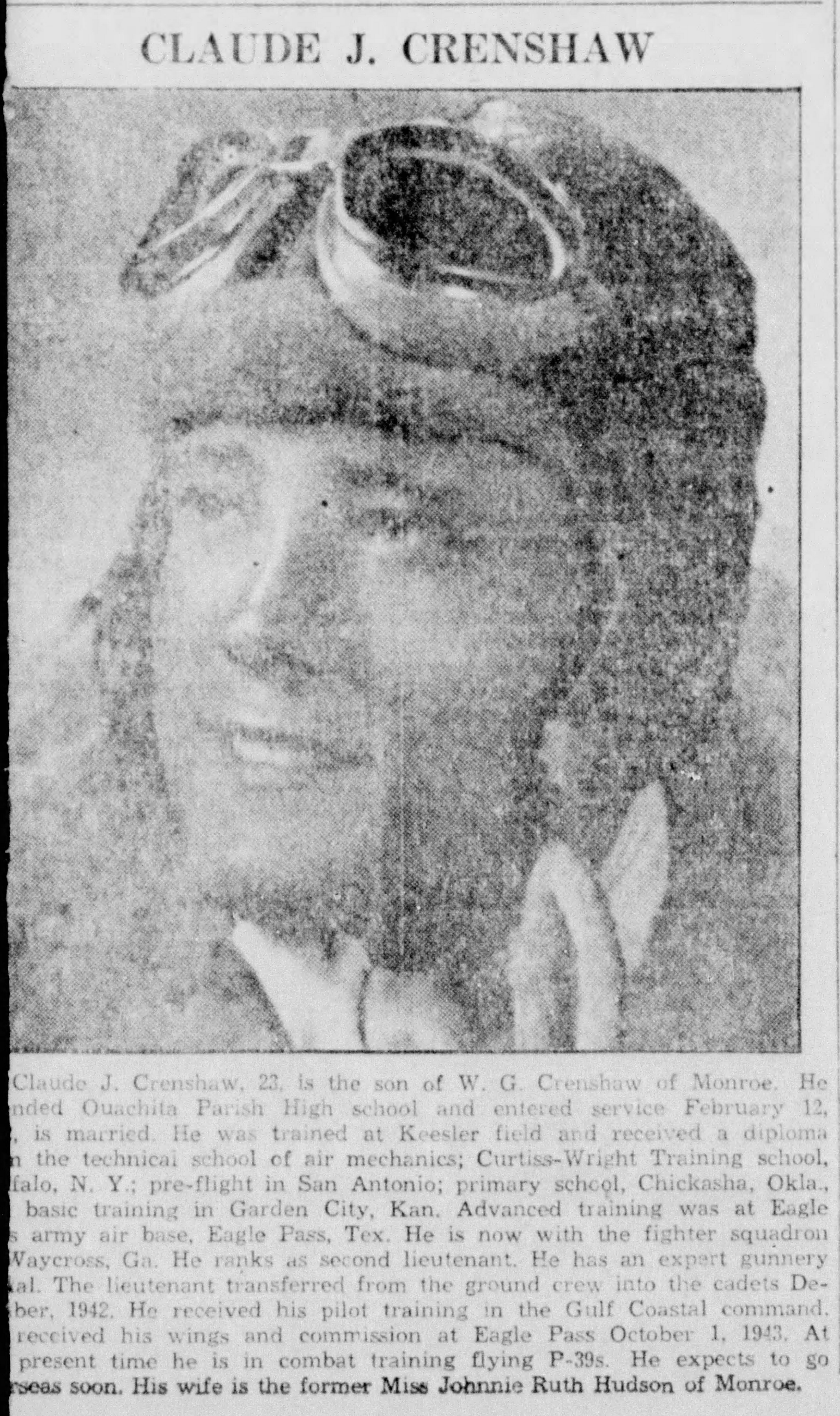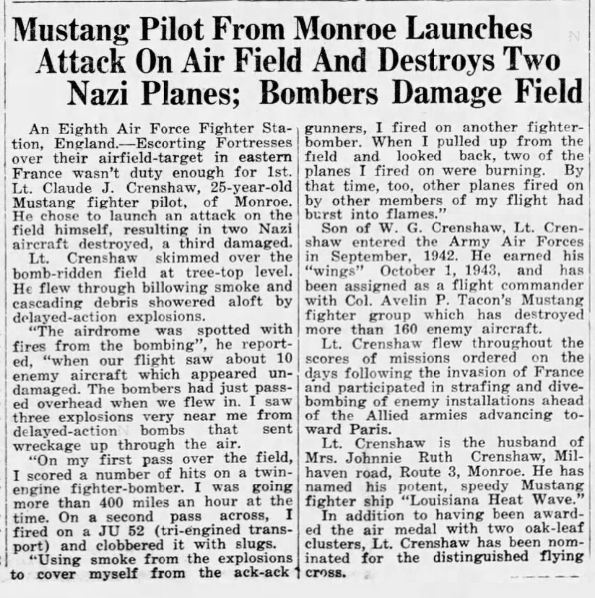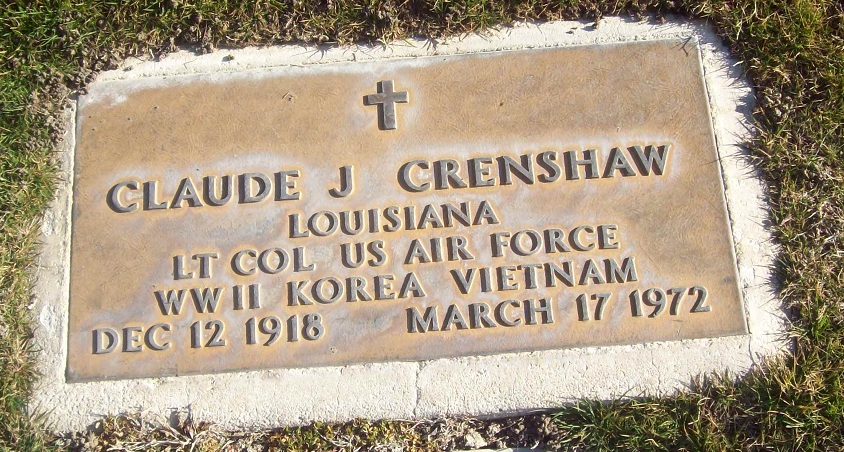A native of Monroe, La., he enlisted in the Army Air Corps in Florida on Feb. 12, 1942. After advanced pilot training at Eagle Pass, Texas, he was assigned to the 359th FG at Station 133, East Wreatham, Norfolk, England.
Officially he is credited with seven air kills, and 3.3 ground kills.
According to a Web site on the restoration of one of his aircraft, "his first two air victories came during a mission on September 11th, 1944 to Kollada, just north of Leipzig, Germany. During an encounter with about 100 ME-109s, he shot down two enemy aircraft in his P-51D named Louisiana Heatwave. After this encounter, he and his wingman strafed an airfield and he scored one of his ground victories.
"His next air victory came just a week later, on September 18th, during a mission to Dusseldorf. As he began to chase a ME-109, he saw over his shoulder another ME-109 chasing his wingman, Lt. Russel Jenner. Jenner's radio was out and had been unable to radio for help. Crenshaw abandoned his chase and climbed back up to help his wingman. After a turning battle, he shot down the German fighter and escorted his wingman home.
"November 21st, 1944 was a busy day and mission in the vicinity of Merseburg, when he ran into several large gaggles of enemy fighters. In rapid succession, he shot down five enemy FW-190 fighters, but was awarded four victories and one probable. Upon arrival back at Wreatham, it was discovered that only three of his six .50 caliber guns had been working. Crenshaw credited his high score to his new G-Suit and the K-14 Gyro Gun Sight, which enabled him to complete violent maneuvers and accurately target enemy aircraft. After the mission, Claude shared a photo op with Ace George Preddy and Ace William Whisner.
"Crenshaw received the Distinguished Service Cross for this mission by command of General Carl A. Spaatz who wrote, "The outstanding heroism and determination to destroy the enemy displayed by Captain Crenshaw are in keeping with the highest traditions of the Armed Forces of the United States." Crenshaw's descorations in addition to the DSC include the Distinguished Flying Cross with One Oak Leaf Cluster, and the Air Medal with Nine Oak Leaf Clusters.
"After his nine month tour in the European Theatre, he was returned to the US, arriving on January 1st, 1945. Captain Crenshaw was stationed at various fields in the US as a fighter pilot instructor, and trained Mexican and Turkish pilots in fighter pilot tactics in Abilene Texas.
"Post-war, (based on accident report and other information) Captain Crenshaw was assigned to the 62nd FS/56th FG based at Selfridge Field Michigan. During this time, the 56th FG was sent to Ladd AFB Alaska flying the P-51H, during the Berlin Crisis.
"Subsequently, he moved to the 82nd FG based at Grenier Field, New Hampshire, where again he flew the P-51H and found himself back in Alaska. Later he served as the recruiting officer at Grenier.
"While with the 82nd, Lt. Crenshaw had his P-51H #44-64195 emblazoned with his "Louisiana Heatwave" nose art, and 11 victory markings representing his 10.3 victory credits. The aircraft also carried the markings of the 82nd FG, sporting yellow spinner, fin tips and black outlined broad yellow stripe across the vertical stabilizer.
"He remained in the US Air Force as a fighter pilot, retiring in 1965 with the rank of Lt. Colonel. During this time, Claude flew what was in its day, the hottest fighter in USAF inventory, the Lockheed F-104 Starfighter.
"Based on the patches on Claude Crenshaw's flight jacket shown, then-Major Crenshaw had at one point been assigned to the 479th Fighter Group from Holloman AFB New Mexico, the 56th Fighter Interceptor Squadron at Wright-Patterson AFB Ohio, and the 436th Fighter Bomber Squadron at George AFB California.
"Claude Crenshaw passed away on March 17th, 1972 in San Bernadino California."
A native of Monroe, La., he enlisted in the Army Air Corps in Florida on Feb. 12, 1942. After advanced pilot training at Eagle Pass, Texas, he was assigned to the 359th FG at Station 133, East Wreatham, Norfolk, England.
Officially he is credited with seven air kills, and 3.3 ground kills.
According to a Web site on the restoration of one of his aircraft, "his first two air victories came during a mission on September 11th, 1944 to Kollada, just north of Leipzig, Germany. During an encounter with about 100 ME-109s, he shot down two enemy aircraft in his P-51D named Louisiana Heatwave. After this encounter, he and his wingman strafed an airfield and he scored one of his ground victories.
"His next air victory came just a week later, on September 18th, during a mission to Dusseldorf. As he began to chase a ME-109, he saw over his shoulder another ME-109 chasing his wingman, Lt. Russel Jenner. Jenner's radio was out and had been unable to radio for help. Crenshaw abandoned his chase and climbed back up to help his wingman. After a turning battle, he shot down the German fighter and escorted his wingman home.
"November 21st, 1944 was a busy day and mission in the vicinity of Merseburg, when he ran into several large gaggles of enemy fighters. In rapid succession, he shot down five enemy FW-190 fighters, but was awarded four victories and one probable. Upon arrival back at Wreatham, it was discovered that only three of his six .50 caliber guns had been working. Crenshaw credited his high score to his new G-Suit and the K-14 Gyro Gun Sight, which enabled him to complete violent maneuvers and accurately target enemy aircraft. After the mission, Claude shared a photo op with Ace George Preddy and Ace William Whisner.
"Crenshaw received the Distinguished Service Cross for this mission by command of General Carl A. Spaatz who wrote, "The outstanding heroism and determination to destroy the enemy displayed by Captain Crenshaw are in keeping with the highest traditions of the Armed Forces of the United States." Crenshaw's descorations in addition to the DSC include the Distinguished Flying Cross with One Oak Leaf Cluster, and the Air Medal with Nine Oak Leaf Clusters.
"After his nine month tour in the European Theatre, he was returned to the US, arriving on January 1st, 1945. Captain Crenshaw was stationed at various fields in the US as a fighter pilot instructor, and trained Mexican and Turkish pilots in fighter pilot tactics in Abilene Texas.
"Post-war, (based on accident report and other information) Captain Crenshaw was assigned to the 62nd FS/56th FG based at Selfridge Field Michigan. During this time, the 56th FG was sent to Ladd AFB Alaska flying the P-51H, during the Berlin Crisis.
"Subsequently, he moved to the 82nd FG based at Grenier Field, New Hampshire, where again he flew the P-51H and found himself back in Alaska. Later he served as the recruiting officer at Grenier.
"While with the 82nd, Lt. Crenshaw had his P-51H #44-64195 emblazoned with his "Louisiana Heatwave" nose art, and 11 victory markings representing his 10.3 victory credits. The aircraft also carried the markings of the 82nd FG, sporting yellow spinner, fin tips and black outlined broad yellow stripe across the vertical stabilizer.
"He remained in the US Air Force as a fighter pilot, retiring in 1965 with the rank of Lt. Colonel. During this time, Claude flew what was in its day, the hottest fighter in USAF inventory, the Lockheed F-104 Starfighter.
"Based on the patches on Claude Crenshaw's flight jacket shown, then-Major Crenshaw had at one point been assigned to the 479th Fighter Group from Holloman AFB New Mexico, the 56th Fighter Interceptor Squadron at Wright-Patterson AFB Ohio, and the 436th Fighter Bomber Squadron at George AFB California.
"Claude Crenshaw passed away on March 17th, 1972 in San Bernadino California."
Inscription
Lt. Col. U.S. Air Force; WWII, Korea, Vietnam
Family Members
Sponsored by Ancestry
Advertisement
Explore more
Sponsored by Ancestry
Advertisement
